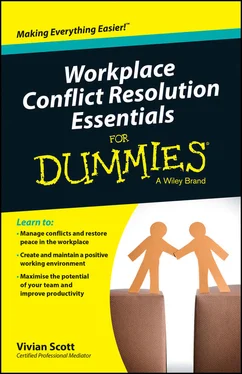In this chapter, I give you an overview of conflict resolution so you can successfully mediate problems in your workplace, whether those problems are between two individuals or within a larger group. I also tell you about additional conflict resolution resources you may have at your disposal.
Considering Common Contributors to Conflict
For the most part, workplace difficulties fall into common categories, such as
 Communication (and miscommunication)
Communication (and miscommunication)
 Employee attitudes
Employee attitudes
 Honesty
Honesty
 Insubordination
Insubordination
 Treatment of others
Treatment of others
 Work habits
Work habits
Effectively addressing conflict takes into account the obvious surface issue, the emotional climate surrounding the topic, and your knowledge of the viewpoints of the people involved in the dispute. In this section, I provide insight into how differing perspectives can cause employees to feel like ships passing in the night. I also discuss emotions, touch on the importance of communication in your organisation, and look at group dynamics, including your role in the group.
Acknowledging differing perspectives
You and each of the employees on your team have a lens through which you see the world and one another. Everything you see, hear and say goes through your filter on the way in and on the way out. These filters determine how you present and receive information.
Your individual kaleidoscope is shaped by things like your personal history, education, values, culture and the roles you play in your life, both at work and at home. Everything you consider important works together to create your worldview. The same is true for your co-workers.
 Values in this context are things like safety, respect, autonomy and recognition.
Values in this context are things like safety, respect, autonomy and recognition.
Being familiar with your employees’ and colleagues’ values helps you resolve conflicts. For example, say that two employees are having an argument over where to stack some binders. If you can appreciate that one employee sees respect as paramount in his environment, and that his workspace is being encroached by his colleague with a lackadaisical attitude toward boundaries, you have a better chance of helping the two resolve the issue. Rather than swooping in to tell the pair that the binders they’re arguing about should go on a shelf, you can facilitate a conversation about the real issue – respect. After you address the issue of respect, where the binders should go will be relatively easy to decide.
In Chapter 2 Chapter 2 Understanding What People Bring to Conflict In This Chapter Reviewing communication Understanding the individual’s perspective Shedding light on emotions Addressing common responses to conflict E ach person in your workplace is a complex system of past experiences, beliefs, values, opinions and emotions. Each has different ways of communicating, processing the things around him or her, and handling conflict. This chapter helps you gain a better insight into the people on your team – why they see things the way they do, why they react to different people in different ways, and how their emotions can complicate the whole situation. You can start to understand how your colleagues’ personal beliefs and attributes contribute to the team dynamic and sometimes contribute to conflict (which is normal, natural and inevitable, by the way) so that you can build better working relationships and a more productive working environment. You’ll see the broader foundation of conflict and be more prepared to proactively reduce and perhaps prevent it.
, I go into more detail about filters, values and the emotions individuals bring to conflict.
Recognising emotions in others
Most organisations embrace positive emotions. Where managers often falter is in failing to recognise that every emotion – from upbeat to angry – is a clue to discovering people’s personal values. Positive emotions are a sign that values are being met, while negative ones suggest that some work still needs to be done!
It’s obvious that a situation has turned emotional when tears flow or an employee ratchets up the volume when he speaks, to the point that the entire office slips into an uncomfortable silence. What’s a little more difficult is knowing what to do with such passionate responses. Emotional reactions are often seen as negative behaviour in just about any workplace, but if you spend some time investigating and interpreting them, you can get a leg up on how to resolve the trouble. Check out Chapter 2 Chapter 2 Understanding What People Bring to Conflict In This Chapter Reviewing communication Understanding the individual’s perspective Shedding light on emotions Addressing common responses to conflict E ach person in your workplace is a complex system of past experiences, beliefs, values, opinions and emotions. Each has different ways of communicating, processing the things around him or her, and handling conflict. This chapter helps you gain a better insight into the people on your team – why they see things the way they do, why they react to different people in different ways, and how their emotions can complicate the whole situation. You can start to understand how your colleagues’ personal beliefs and attributes contribute to the team dynamic and sometimes contribute to conflict (which is normal, natural and inevitable, by the way) so that you can build better working relationships and a more productive working environment. You’ll see the broader foundation of conflict and be more prepared to proactively reduce and perhaps prevent it.
for a complete discussion of emotions at work.
Handling communication mishaps
Communication makes the world go round, and the same is true for you and your employees. Word choice, tone of voice and body language all contribute to whether or not you understand each other.
Using vague or confusing language causes communication misfires. Phrases such as ‘when you get a chance’, ‘several’, or ‘sometimes’ don’t accurately state what you really mean. Similarly, words like ‘always’ and ‘never’ can get you in trouble. Choosing your words wisely, and in a way that invites dialogue, makes for a less stressful work environment and models good communication. See Chapter 2 Chapter 2 Understanding What People Bring to Conflict In This Chapter Reviewing communication Understanding the individual’s perspective Shedding light on emotions Addressing common responses to conflict E ach person in your workplace is a complex system of past experiences, beliefs, values, opinions and emotions. Each has different ways of communicating, processing the things around him or her, and handling conflict. This chapter helps you gain a better insight into the people on your team – why they see things the way they do, why they react to different people in different ways, and how their emotions can complicate the whole situation. You can start to understand how your colleagues’ personal beliefs and attributes contribute to the team dynamic and sometimes contribute to conflict (which is normal, natural and inevitable, by the way) so that you can build better working relationships and a more productive working environment. You’ll see the broader foundation of conflict and be more prepared to proactively reduce and perhaps prevent it.
for more tips on communicating effectively.
Читать дальше

 Communication (and miscommunication)
Communication (and miscommunication) Employee attitudes
Employee attitudes Honesty
Honesty Insubordination
Insubordination Treatment of others
Treatment of others Work habits
Work habits Values in this context are things like safety, respect, autonomy and recognition.
Values in this context are things like safety, respect, autonomy and recognition.










